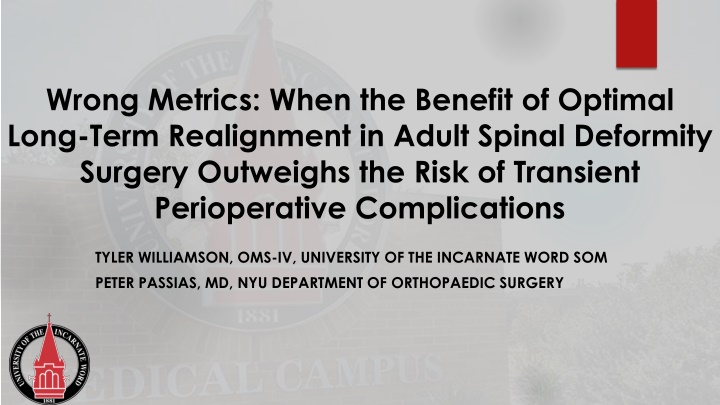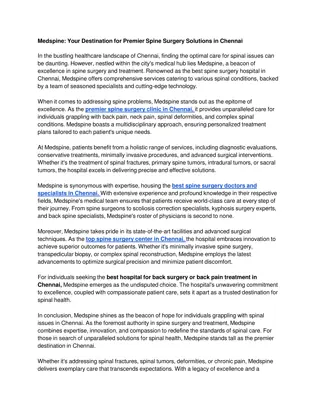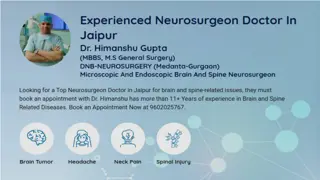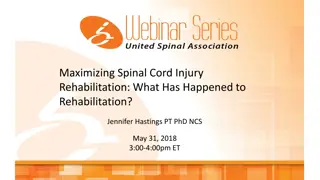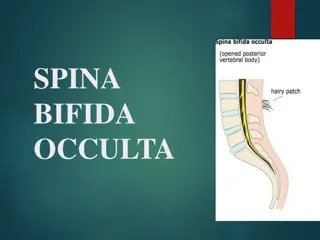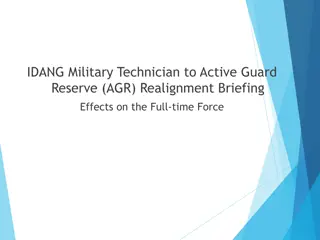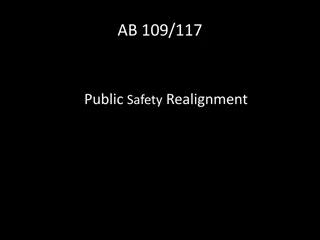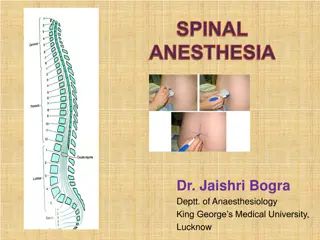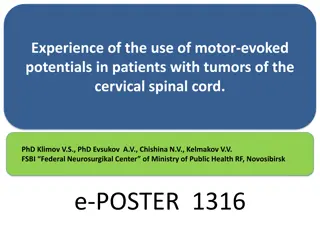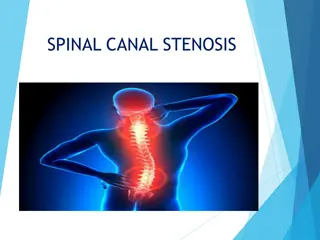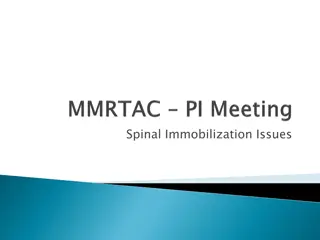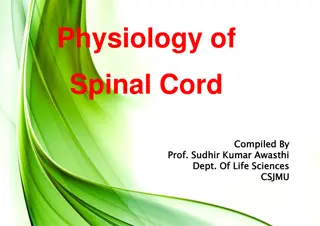Benefit of Long-Term Realignment in Adult Spinal Deformity Surgery
Recent literature highlights the benefits of surgical intervention for adult spinal deformity, despite the potential for transient perioperative complications. This study aims to explore the long-term outcomes of optimal realignment in ASD surgery, emphasizing the significance of achieving improved patient quality of life and disease burden reduction.
Uploaded on Oct 07, 2024 | 4 Views
Download Presentation

Please find below an Image/Link to download the presentation.
The content on the website is provided AS IS for your information and personal use only. It may not be sold, licensed, or shared on other websites without obtaining consent from the author.If you encounter any issues during the download, it is possible that the publisher has removed the file from their server.
You are allowed to download the files provided on this website for personal or commercial use, subject to the condition that they are used lawfully. All files are the property of their respective owners.
The content on the website is provided AS IS for your information and personal use only. It may not be sold, licensed, or shared on other websites without obtaining consent from the author.
E N D
Presentation Transcript
Wrong Metrics: When the Benefit of Optimal Long-Term Realignment in Adult Spinal Deformity Surgery Outweighs the Risk of Transient Perioperative Complications TYLER WILLIAMSON, OMS-IV, UNIVERSITY OF THE INCARNATE WORD SOM PETER PASSIAS, MD, NYU DEPARTMENT OF ORTHOPAEDIC SURGERY
Background Recent literature has shown that surgical intervention can significantly improve patient s quality of life and lessen disease burden. (Segreto, 2020) Technological advancements in spine surgery allow modern spine surgeons to take on more challenging and complex patients during corrective spine surgery.
Background An increased risk of perioperative complications comes with increasing complexity in patients, but also with the increased invasiveness and proportioning needed to achieve optimal realignment. Because institutions like Centers for Medicare and Medicaid Services focus on the 90-day postoperative course for both reimbursement and hospital performance purposes, great emphasis has been placed on the perioperative outcomes in adult spinal deformity (ASD) surgery.
Background However, it remains to be seen whether too much emphasis is being placed on the perioperative course, and if these significantly impact the long- term outcomes. Even more so, some patients may persevere through these short-term, transient complications and manage to still achieve optimal, long-term outcomes.
Objective There remains a paucity of literature exploring the specific patient characteristics and aspects of their care that contribute to this success despite a rough start. Therefore, we sought to demonstrate the superiority in long- term outcomes of achieving optimal realignment despite the increased risk of transient perioperative complications.
Methods Inclusion Criteria Operative ASD patients: Coronal Cobb angle >20 Sagittal Vertebral Axis (SVA) >5cm Pelvic Tilt (PT) >25 Thoracic Kyphosis (TK) >60 with available baseline (BL) and 2-year (2Y) health-related quality of life (HRQL) data were included.
Methods Patients were stratified based on optimal or suboptimal outcomes at 2 years. Optimal outcome was defined by: Improvement in all three age-aligned SRS-Schwab modifiers (SVA, PT, and PI-LL) Being proportioned (P) in the Global Alignment and Proportion Score (Yilgor, 2017) And an Oswestry Disability Index (ODI, modified for back pain) score of less than 25 at 2 years
Methods: Cost Analysis Published methods converted ODI to SF-6D, per Carreon et al. Quality- associated life years (QALYs) utilized a 3% discount rate for residual decline. Cost was calculated using the PearlDiver database and assessed for Complications and Major Complications and Comorbidities according to CMS.gov definitions. Reimbursement consisted of a standardized estimate using regression analysis of Medicare pay- scales for services within a 30-day window. Cost per QALY at 2Y were calculated.
Results Baseline Characteristic Age 59.9+14.7 years Body Mass Index 27.3+5.3 kg/m2 469 ASD patients Procedural Details: Approach 63% Posterior, 37% Combined 66% underwent an osteotomy 52% underwent a decompression Charlson Comorbidity Index 1.63+1.6 ASD Frailty Index 3.12+1.65 Surgical/Admission Characteristic Length of Stay 8.5+4.6 days Number of Levels Fused 11.5+4.0 levels Estimated Blood Loss 1565+1406 mL Operative Time 371+136 min Baseline Radiographic Parameters Pelvic Tilt PI-LL SVA 23.49 11.1 14.4 21.2 63.3 70.7 mm
Results: Group Breakdown Baseline Characteristic Age Body Mass Index Charlson Comorbidity Index ASD Frailty Index Optimal Outcome 57.3+16.3 years Suboptimal Outcome 62.5+12.4 years Optimal Outcome: 105 p-value .005 .007 28.2+5.6 kg/m2 26.4+4.9 kg/m2 Suboptimal Outcome: 364 .373 1.73+1.59 1.54+1.67 .031 Suboptimal group was older with higher BMI and frailty 3.35+1.59 2.90+1.67 Surgical/Admission Characteristic 8.6+5.0 days .570 .043 8.3+4.2 days 11.0+4.1 levels Length of Stay Number of Levels Fused Estimated Blood Loss Operative Time Osteotomy Decompression 12.0+3.9 levels Optimal group had more levels fused, osteotomies, and less decompressions .038 1755+1508 mL 1385+1283 mL .236 .005 .002 382+131 min 66% 62% 362+141 min 81% 43%
Complication within 90 days Adverse Event Minor Complication Major Complication Any Perioperative Complication Medical Complication Musculoskeletal Cardiac GI Infection Neurological Pulmonary Renal Implant Failure Instrumentation Failure X-ray Imbalance PJK at 6W* PJK at 2Y* PJF by 2Y* Reoperation by 2Y Suboptimal Outcome 0.146 Optimal Outcome .114 Results: Complications p-value .414 0.362 .929 0.357 Optimal Outcome: 0.191 .024 0.302 More perioperative complications (58% vs 53%, p=.334) 0.581 .334 0.528 0.105 .537 0.085 More gastrointestinal complications (10.5% vs 4.7%, p=.027) .060 .228 .027 .165 .065 .769 .592 .087 .031 0.000 0.010 0.105 0.010 0.019 0.048 0.000 0.143 0.033 0.022 0.047 0.036 0.066 0.055 0.003 0.214 Less major complications (19.1% vs 30.2%, p=.024) Less instrumentation failure (7.6% vs 15.9%) 0.076 0.159 .106 0.029 0.044 Less reoperations (12.4% vs 25.6%, p=.004) .111 .189 .392 0.229 0.267 0.057 0.305 0.332 0.082 0.124 .004 0.256 *PJK Proximal Junctional Kyphosis; PJF Proximal Junctional Failure
Results: Cost Analysis Optimal Outcome gained more utility based on patient-reported outcomes by two years Due to less major complications and reoperations, Optimal Outcome also had a lower two-year cost p-value Suboptimal Outcome .074 Optimal Outcome .147 Therefore, the Optimal Outcome generated a lower overall cost- effectiveness by two years <.001 Utility Gained 2-Year QALYs Overall Cost at 2 years Cost per QALY at 2 years .144 .285 <.001 $93,133.00 $76,958.48 <.001 $648,409.34 $269,722.10 <.001
Conclusion Despite undergoing more invasive procedures and sustaining more perioperative complications, patients who met our optimal outcome criteria experienced significantly less major and mechanical complications, underwent fewer reoperations, and had a lower rate of both PJK and PJF at two years postoperatively. Accordingly, a higher, transient perioperative complication profile should not preclude surgical correction in ASD patients who demonstrate baseline characteristics suggestive of successful long-term outcomes.
References Segreto FA, Passias PG, Brown AE, Horn SR, Bortz CA, Pierce KE, Alas H, Lafage V, Lafage R, Smith JS, Line BG, Diebo BG, Kelly MP, Mundis GM, Protopsaltis TS, Soroceanu A, Kim HJ, Klineberg EO, Burton DC, Hart RA, Schwab FJ, Bess S, Shaffrey CI, Ames CP. The Influence of Surgical Intervention and Sagittal Alignment on Frailty in Adult Cervical Deformity. Oper Neurosurg (Hagerstown). 2020 Jun 1;18(6):583-589. doi: 10.1093/ons/opz331. PMID: 31701155. Yilgor C, Sogunmez N, Boissiere L, Yavuz Y, Obeid I, Kleinst ck F, P rez-Grueso FJS, Acaroglu E, Haddad S, Mannion AF, Pellise F, Alanay A; European Spine Study Group (ESSG). Global Alignment and Proportion (GAP) Score: Development and Validation of a New Method of Analyzing Spinopelvic Alignment to Predict Mechanical Complications After Adult Spinal Deformity Surgery. J Bone Joint Surg Am. 2017 Oct 4;99(19):1661-1672. doi: 10.2106/JBJS.16.01594. PMID: 28976431. Kim HJ, York PJ, Elysee JC, Shaffrey C, Burton DC, Ames CP, Mundis GM Jr, Hostin R, Bess S, Klineberg E, Smith JS, Passias P, Schwab F, Lafage R; International Spine Study Group(ISSG). Cervical, Thoracic, and Spinopelvic Compensation After Proximal Junctional Kyphosis (PJK): Does Location of PJK Matter? Global Spine J. 2020 Feb;10(1):6-12. doi: 10.1177/2192568219879085. Epub 2019 Sep 30. Carreon LY, Glassman SD, McDonough CM, Rampersaud R, Berven S, Shainline M. Predicting SF- 6D utility scores from the Oswestry disability index and numeric rating scales for back and leg pain. Spine (Phila Pa 1976). 2009 Sep 1;34(19):2085-9. doi: 10.1097/BRS.0b013e3181a93ea6. PMID: 19730215; PMCID: PMC3504506.
